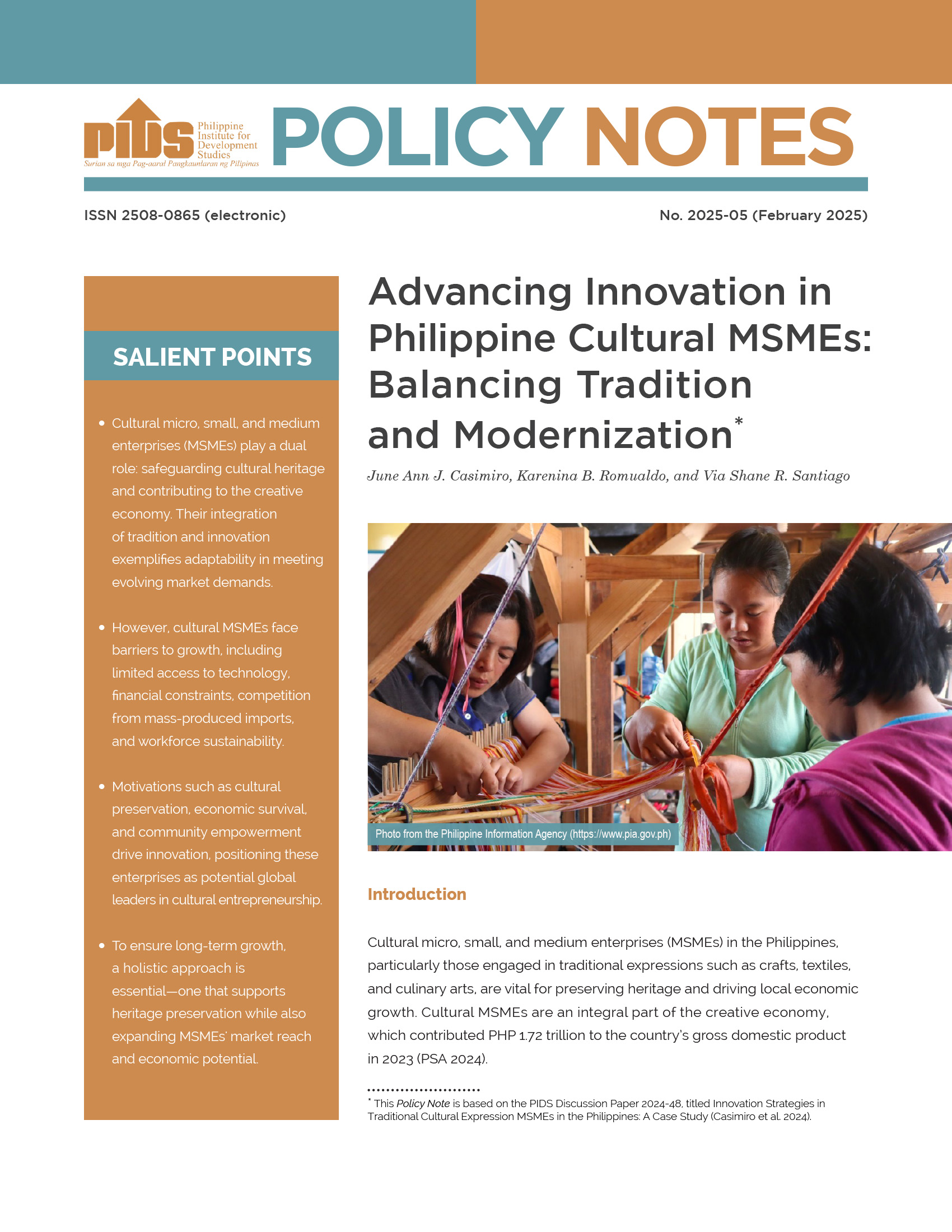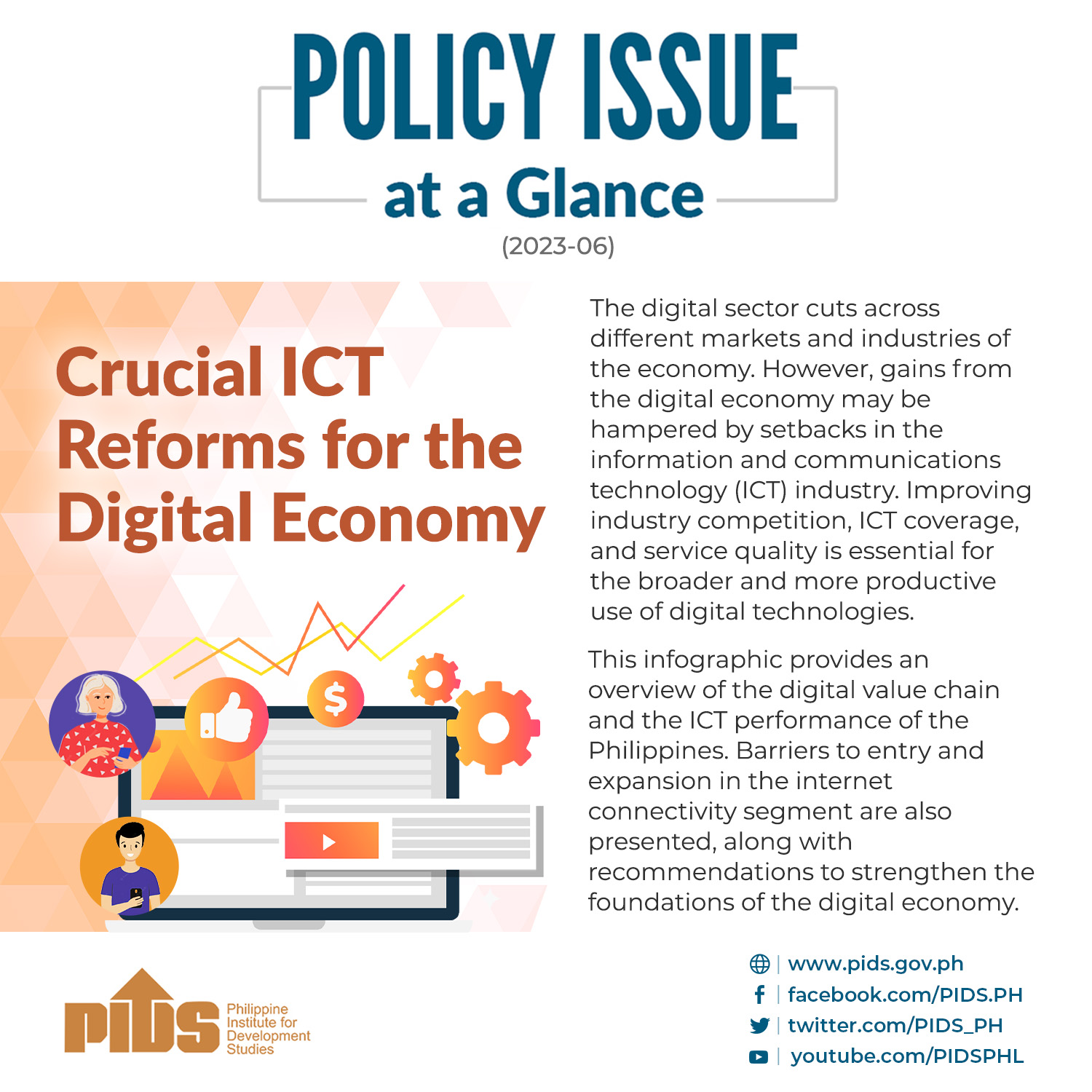
Despite the growing digital economy in the Philippines, the adoption rate of e-commerce among firms is low, a study published by state think tank Philippine Institute for Development Studies (PIDS) revealed.
The study, authored by PIDS Senior Research Fellow Francis Mark Quimba and Research Analyst Sylwyn Calizo, found that only 1 in every 7 firms in the country adopted e-commerce in 2015.
Furthermore, based on 2013 and 2015 data from the Survey of Information and Communications Technology, only 15 percent of firms have made purchases or sales through the internet. While majority of these firms are stock corporations, the study noted an “increase in the number of government corporations that are engaged in e-commerce,” adding that “2 in every 100 e-commerce firms are government corporations.”
From 2013 to 2015, the “average proportion of firms utilizing e-commerce in the country has remained virtually unchanged, which implies that the industries are unable to keep pace with the use of available technology in their business operations,” according to the authors.
Looking into the profile of firms that are adopting e-commerce, the study found that companies using information and communications technology (ICT) in their finance, accounting, logistics, and research and development departments, “have a higher likelihood of adopting e-commerce”. The study also noted that the more computers the firm has, the more likely it is going to adopt e-commerce.
The size of a firm also affects its adoption of e-commerce. E-commerce adoption is highest among large companies at about 15.7 percent. Meanwhile, e-commerce adoption among micro and small firms saw an increase from 5.9 percent in 2013 to 6.2 percent in 2015 and from 13.8 percent to 14.6 percent, respectively.
The study also said that those in the industry and services sector are more likely to fully adopt e-commerce, compared to those in the manufacturing and primary sectors. Industries with the highest proportion of establishments adopting e-commerce include water supply, sewerage, waste management, and remediation activities at 33.1 percent, followed by human health and social work at 25.3 percent, and accommodation and food service at 25.1 percent.
Meanwhile, the study mentioned that “financial and insurance activities, as well as real estate activities, have seen very sharp declines in the share of establishments with e-commerce [through] the internet.”
All over the country, e-commerce adoption is most prevalent in the National Capital Region, Central Luzon, and CALABARZON—comprising “more than half of e-commerce firms in 2013 and around 70.0 percent in 2015”. Central Visayas and Davao Region have the largest share of firms adopting e-commerce in Visayas and Mindanao, respectively.
Given these results, the authors urged the government and private sector, particularly the micro, small, and medium enterprises (MSMEs) to adopt e-commerce in their firms.
“E-commerce adoption has been reported to benefit firms through increased efficiency by reducing transaction time and reducing marketing time. Firms in 2015 have also increased recognition of other benefits, such as improving customer service and providing more personalized customer service,” they explained.
Investigating the bottlenecks to firms’ e-commerce adoption, the study found that the primary reason was their preference to maintain their current business model. Security and privacy concerns, unreliable internet connection, incompatibility of computer systems between consumers and suppliers, and the high development and maintenance costs of an e-commerce system were the other reasons found.
To address privacy and security concerns, the study urged the firms to strengthen their awareness on data security, as well as their capability to protect their e-commerce platforms.
The authors also provided several policy recommendations addressed to the government, particularly on how to help MSMEs, which “may have difficulty adopting to e-commerce”.
One is targeted support through the provision of financial access to MSMEs so they can invest on computers and reliable internet connection—a must in e-commerce adoption. Another is by encouraging firms to adopt e-commerce by teaching them on how to apply ICT in their day-to-day operations. Lastly, reducing the cost of and improving internet services in the country is necessary. ###
This press release is based on the PIDS discussion paper titled “Determinants of E-Commerce Adoption of Philippine Businesses.”
The study, authored by PIDS Senior Research Fellow Francis Mark Quimba and Research Analyst Sylwyn Calizo, found that only 1 in every 7 firms in the country adopted e-commerce in 2015.
Furthermore, based on 2013 and 2015 data from the Survey of Information and Communications Technology, only 15 percent of firms have made purchases or sales through the internet. While majority of these firms are stock corporations, the study noted an “increase in the number of government corporations that are engaged in e-commerce,” adding that “2 in every 100 e-commerce firms are government corporations.”
From 2013 to 2015, the “average proportion of firms utilizing e-commerce in the country has remained virtually unchanged, which implies that the industries are unable to keep pace with the use of available technology in their business operations,” according to the authors.
Looking into the profile of firms that are adopting e-commerce, the study found that companies using information and communications technology (ICT) in their finance, accounting, logistics, and research and development departments, “have a higher likelihood of adopting e-commerce”. The study also noted that the more computers the firm has, the more likely it is going to adopt e-commerce.
The size of a firm also affects its adoption of e-commerce. E-commerce adoption is highest among large companies at about 15.7 percent. Meanwhile, e-commerce adoption among micro and small firms saw an increase from 5.9 percent in 2013 to 6.2 percent in 2015 and from 13.8 percent to 14.6 percent, respectively.
The study also said that those in the industry and services sector are more likely to fully adopt e-commerce, compared to those in the manufacturing and primary sectors. Industries with the highest proportion of establishments adopting e-commerce include water supply, sewerage, waste management, and remediation activities at 33.1 percent, followed by human health and social work at 25.3 percent, and accommodation and food service at 25.1 percent.
Meanwhile, the study mentioned that “financial and insurance activities, as well as real estate activities, have seen very sharp declines in the share of establishments with e-commerce [through] the internet.”
All over the country, e-commerce adoption is most prevalent in the National Capital Region, Central Luzon, and CALABARZON—comprising “more than half of e-commerce firms in 2013 and around 70.0 percent in 2015”. Central Visayas and Davao Region have the largest share of firms adopting e-commerce in Visayas and Mindanao, respectively.
Given these results, the authors urged the government and private sector, particularly the micro, small, and medium enterprises (MSMEs) to adopt e-commerce in their firms.
“E-commerce adoption has been reported to benefit firms through increased efficiency by reducing transaction time and reducing marketing time. Firms in 2015 have also increased recognition of other benefits, such as improving customer service and providing more personalized customer service,” they explained.
Investigating the bottlenecks to firms’ e-commerce adoption, the study found that the primary reason was their preference to maintain their current business model. Security and privacy concerns, unreliable internet connection, incompatibility of computer systems between consumers and suppliers, and the high development and maintenance costs of an e-commerce system were the other reasons found.
To address privacy and security concerns, the study urged the firms to strengthen their awareness on data security, as well as their capability to protect their e-commerce platforms.
The authors also provided several policy recommendations addressed to the government, particularly on how to help MSMEs, which “may have difficulty adopting to e-commerce”.
One is targeted support through the provision of financial access to MSMEs so they can invest on computers and reliable internet connection—a must in e-commerce adoption. Another is by encouraging firms to adopt e-commerce by teaching them on how to apply ICT in their day-to-day operations. Lastly, reducing the cost of and improving internet services in the country is necessary. ###
This press release is based on the PIDS discussion paper titled “Determinants of E-Commerce Adoption of Philippine Businesses.”












